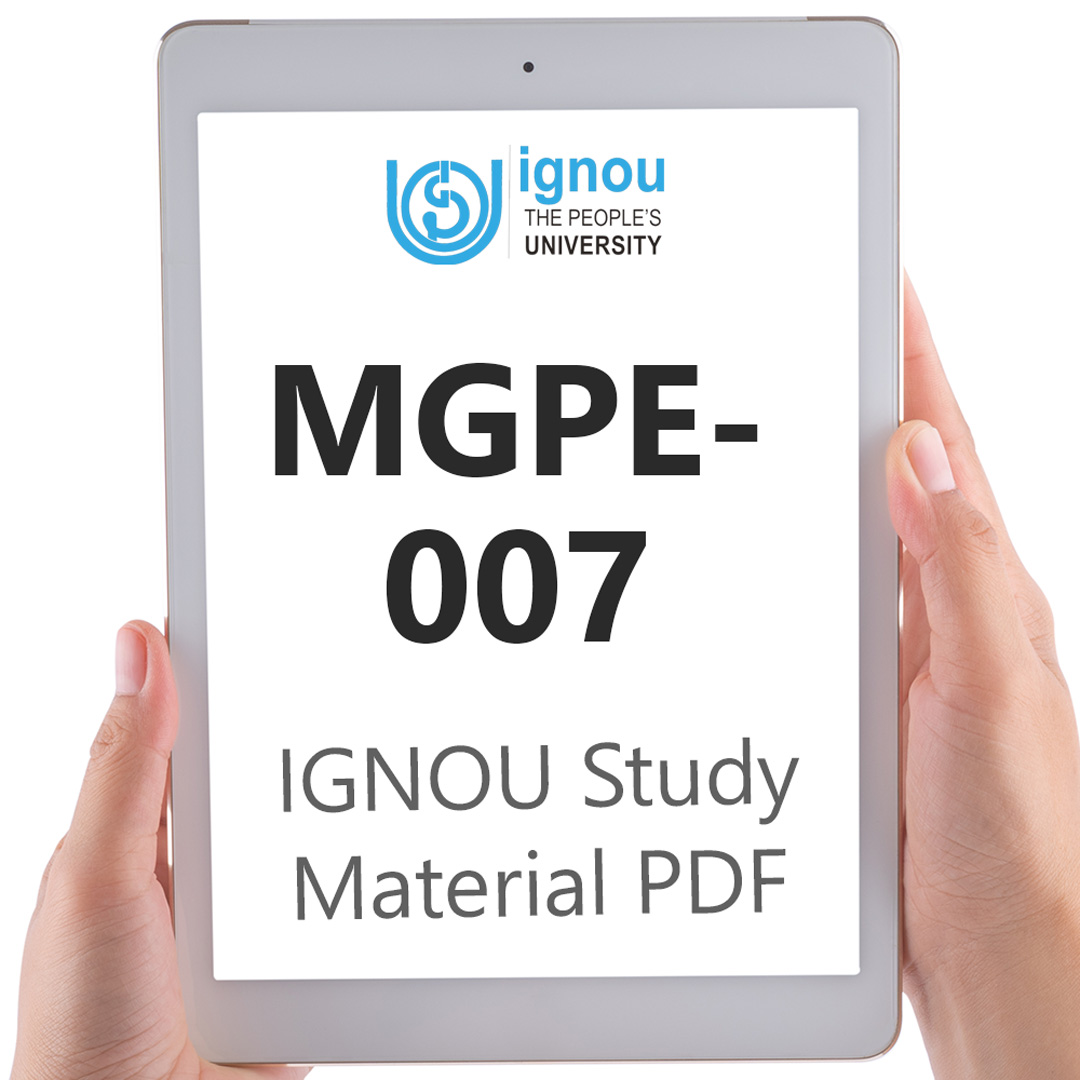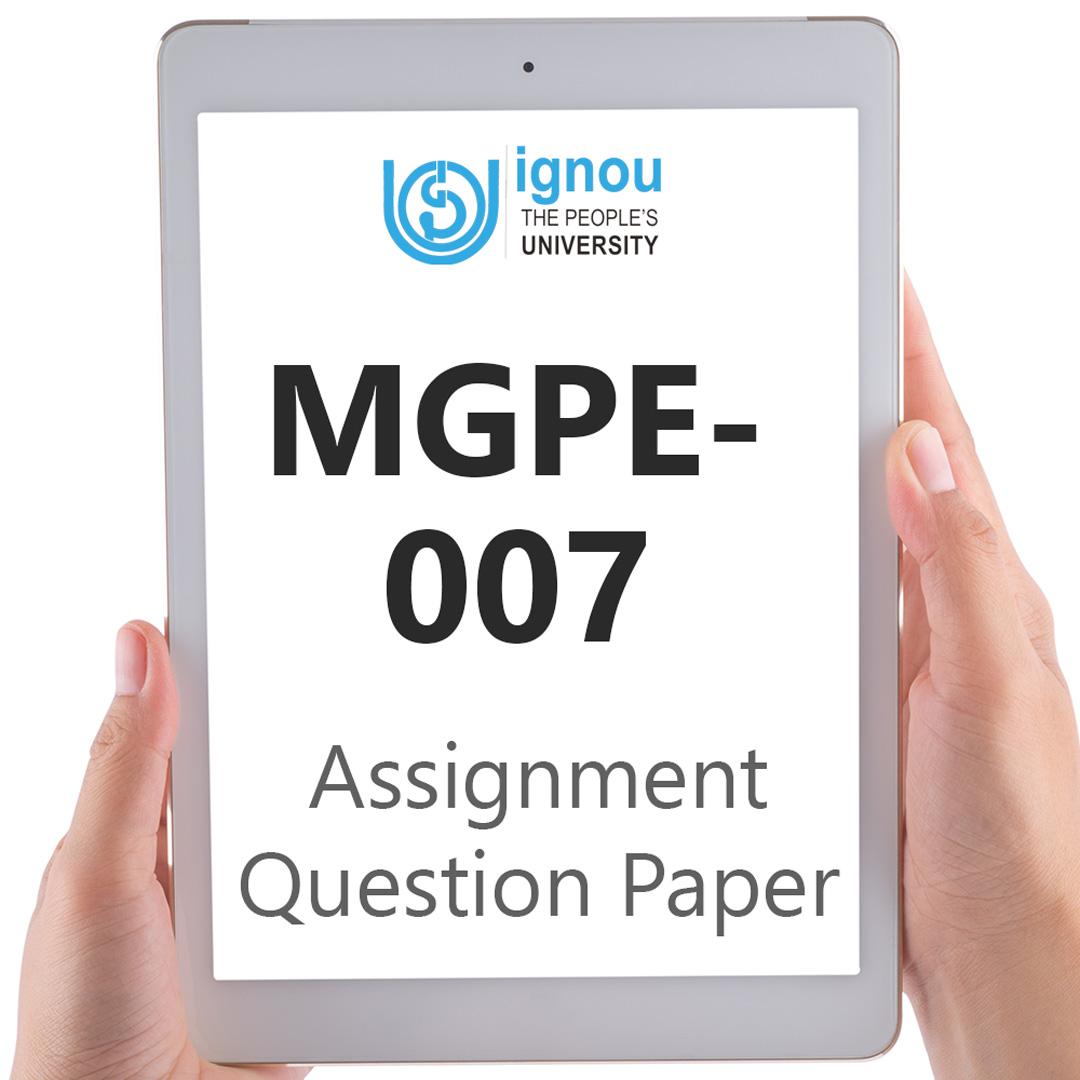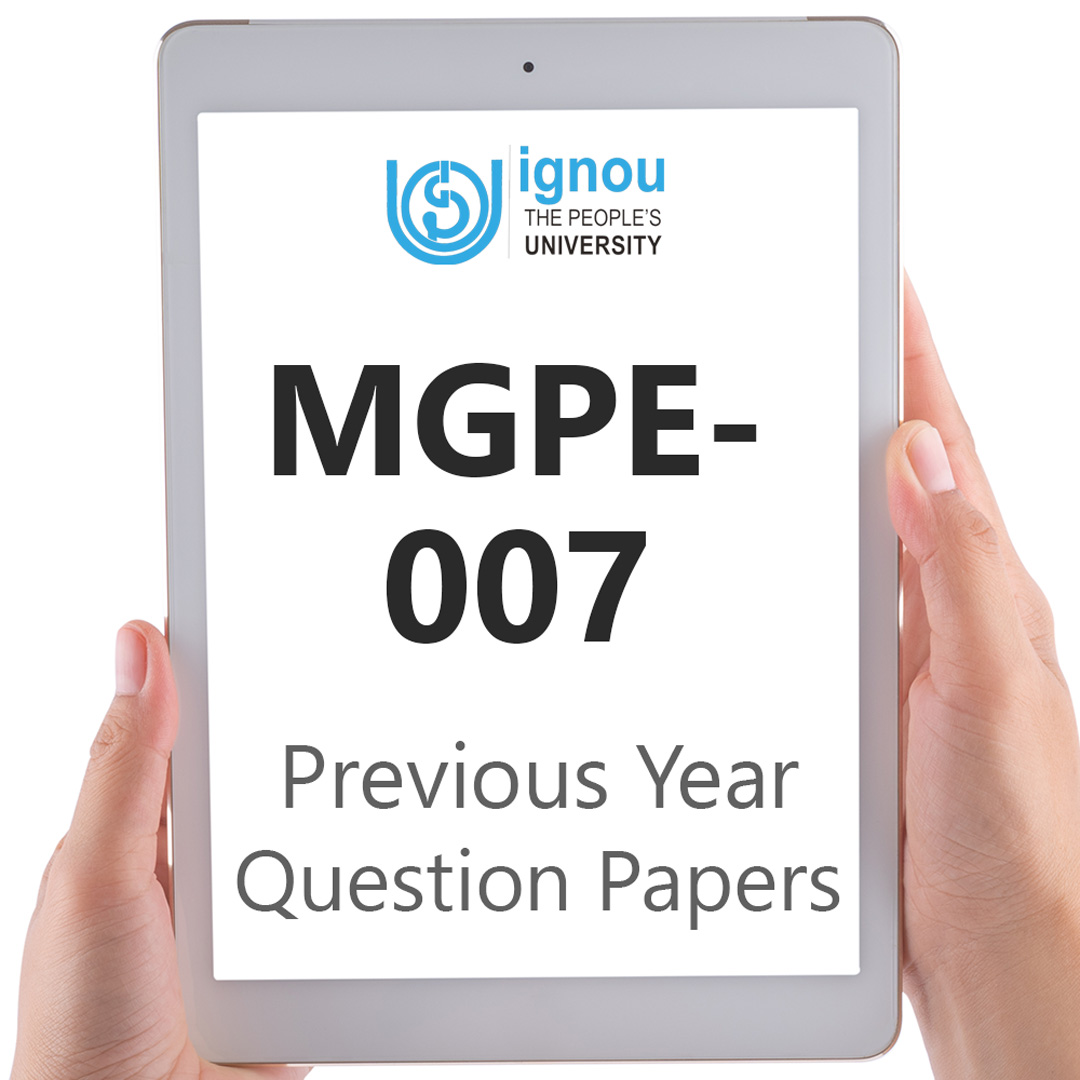If you are looking for MGPE-007 IGNOU Solved Assignment solution for the subject Non-Violent Movements after Gandhi, you have come to the right place. MGPE-007 solution on this page applies to 2022-23 session students studying in MPS, MGPS, PGDGPS, PGCGPS courses of IGNOU.
MGPE-007 Solved Assignment Solution by Gyaniversity
Assignment Code ;MGPE-007/ASST/TMA/2022-23
Course Code: MGPE-007
Assignment Name: Non-Violent Movements After Gandhi
Year: 2022-2023
Verification Status: Verified by Professor
Answer five questions in all, selecting at least two questions from each section. Each question is to be answered in about 500 words. Each question carries 20 marks.
Section-I
Q1) Discuss the role of leadership in peace movements in India.
Ans) Peace movements in India are still in their infancy; they must travel a long way before they become the part of the political life of the country. To be meaningful in their everyday life, peace must mean a decent livelihood, freedom from oppression, access to resources for survival, cultural autonomy, and freedom from violence by the State as well as the powerful. Security for them is not so much national security but people’s security.
Post-Gandhian Leadership
The important thinkers of this school are Vinoba Bhave, Kishorilal Ghanshyam Mashruwala, J.C. Kumarappa, Kaka Kalelkar, Dada Dharmadhikari, Shankerrao Deo, Dhirendra Mazumdar, Jayaprakash Narayan and J. B. Kripalani. All of them, except Jayaprakash Narayan, had been closely associated with Gandhi in his constructive work. Most of them had acquired during the lifetime of Gandhi some prominence both as original thinkers and as interpreters of his thought, and as such their ideas cannot all be strictly considered post-Gandhian. What rather happened after the death of Gandhi is that their thoughts came into greater prominence due to the peace movements and the growth of the movements led to their further elucidation and development.
Kaka Kalelkar also had been a close associate of Gandhi. Before joining him, he was at Shanti Niketan. Later on, he joined Gandhi and subsequently became the Principal of Gujarat Vidyapith. He moved to Wardha later on and edited Sarvodaya- a Hindi monthly. He engaged himself in constructive work and led several peace movements. Dada Dharmadhikari was a prominent Sarvodaya thinker. He was first the publisher and then the co-editor of the Sarvodaya monthly. Later on, when a monthly of the same name was started in August 1949, he became its co-editor with Vinoba as editor and devoted his life for Sarvodaya movement.
Shankerrao Deo had been both a constructive worker and a political leader. He had been the General Secretary of the All-India Congress Committee for a long time. He had completely devoted himself to Sarvodaya activities and was reckoned as one of the leading thinkers of the school. Jayaprakash Narayan was the most prominent Sarvodaya leader after Vinoba. He was one of the founders of the Congress Socialist Party in 1934, and since independence, has been reckoned as the most important political leader after Jawaharlal Nehru. He joined the Sarvodaya movement in 1954 after travelling a long way from Marxian to Gandhian thought. But it did not mean that he ceased to be a socialist.
Another very prominent political figure, who had, in several respects a Sarvodaya outlook, was Acharya J. B. Kripalani, a former president of the Indian National Congress. He had been associated with Gandhi since 1917. He also distinguished himself as a constructive worker, who founded the Gandhi Ashram in Uttar Pradesh and who inspired many young men to dedicate themselves to the cause of constructive work. Kripalani began his career as a teacher in the higher seats of learning and later on became the Principal of Gujarat Vidyapith. Gandhi’s high regard for him is shown by the fact that at times he consulted him on matters which might be considered as purely personal.
Q2) Distinguish between principled and strategic non-violent movement.
Ans) Nonviolence is both a philosophy and a strategy that strives to attain change without the use of violence and can be distinguished into two kinds: movements that use nonviolence on principled grounds and movements that remain nonviolent due to strategic reasons. Nonviolence that is grounded in religious, spiritual, and moral injunctions against violence is called principled, philosophical, or ethical nonviolence. Nonviolence that is based on political or tactical calculations is referred to as strategic, tactical, or pragmatic nonviolence.
A nonviolent movement may have one of these two dimensions as its dominant character. However, as these dimensions are not exclusive, they may be generally present in all nonviolent movements simultaneously. Principled and pragmatic arguments on nonviolence should, therefore, be treated as complimentary. For example, the civil disobedience campaigns during India’s independence movement or during the American civil rights movement- both advanced the level of truth and brought about a change in the balance of power vis-à-vis the government.
Principled Nonviolent Movements
In principled nonviolent struggles, the practitioners explicitly affirm their intent to resolve a conflict without the use of violence and adopt precautions to carry out that intention. In the Gandhian sense, nonviolent movements cannot be waged for purely selfish or arbitrary ends as such ends would fail to unleash the spiritual energies of the people. The followers of nonviolence need to transcend self-interest in order to become effective.
Committed to the values of love, self-sacrifice, and human dignity, they should be prepared to suffer rather than inflict suffering on others. In other words, they should practise nonviolence by conviction rather than by expediency. Adoption of nonviolence by them is a result not of the lack of availability of other alternatives but of the deep abhorrence of dehumanising and brutalising effects of violence, both on the victim and on the executioner.
Strategic Nonviolent Movements
Although many prominent leaders like Mahatma Gandhi and Martin Luther King, Jr. were committed to principled nonviolence, the vast majority of the participants in nonviolent struggles have used nonviolence without deep commitment to its moral and spiritual core. According to the strategic nonviolence perspective, in the most recent cases of nonviolent resistance, the protagonists were not motivated by moral values of love and self-sacrifice. Instead, they selected nonviolent strategy in order to achieve results with means that are more effective and less costly as compared to the violent means. Gene Sharp embodies the pragmatic or strategic approach to nonviolent movements. Consequently, he is often nicknamed as the Clausewitz of nonviolent struggles.
Q3) How did Gandhi define the ecology safety? Explain.
Ans) The term ecology, in its broad sense, means scientific study of plants, animals, or people and institutions in relation to the environment. The main basis of the ecology in environment and the related components are plants, animals, peoples, and institutions. There is ecological balance when all the components harmonize with each other, and nothing occurs that is detrimental to one or more components. An ecological crisis occurs when this equilibrium is disturbed by nature and by man.
Environment is the whole system of biosphere consisting of both biotic and abiotic components interacting with each other and involving a series of cyclic balances. In this system land, water, plants, animals, worms, and humans are linked by a complicated cobweb of interconnections and interdependence. So much so that the entire world and all the living system within it can be looked as one living organism.
From that we can draw an inference that Gandhi’s practice and preaching of an austere life is an important reference point for anyone who is interested in the environmental issues. His simple living and high thinking, apart from the precepts he set forth in his ashrams, speaks volumes of his adherence to the principle of living with nature. As Guha points out, ‘Gandhi’s reservations about the wholesale industrialisation of India are usually ascribed to moral grounds- namely the selfishness and competitiveness of modern society but they also had markedly ecological undertones.’
This is further echoed in the words of Pravin Sheth who remarks that Gandhi warned against three uninterrupted movements that create environmental degradation problems, such as uninterrupted industrialisation, urbanisation, and profit motives of the capitalist system at the cost of developing countries. He further says that ‘Gandhi expected a balanced approach all along the line so as to threat neither man nor nature. Gandhi was ignored when he insisted on such equilibrium between technology, economy, and society. But experiences have forced us to turn to him with appreciation.’
The synchronisation of man-nature relationship was much emphasised by Gandhi but was thoroughly neglected in the post-independent period. To quote Sheth again, ‘in Gandhian paradigm, respect to nature is as intrinsic as respect for diverse traditions, cultures and patterns of community living and livelihood.’ While earlier he was criticised for his so-called utopian ideals, he is now being revered for his views, around which many of the Western as well as Indian environmentalists have begun to congregate. But as is observed, Gandhi himself had an uncanny knack of combining a Utopian vision with shrewdly practical means.
Gandhi’s life of austerity created an example to follow at an individual level; at the societal level, his views found an effective reverberation through the life and works of his close followers like Kumarappa and Mira Behn. Gandhi’s preference for a traditional way of life endowed with natural air, water and sunshine and dislike for urban life is well known. By speaking for voluntary reduction of wants and use of minimum resources, Gandhi set a fine example to emulate for many a generation to come. Undoubtedly, we can say that Gandhi’s ideas and views influenced the later environmental thinking, practice and also created the momentum for further non-violent environmental movements.
Section-II
Write a short note on each part of the question in about 250 words:
Q1) (a) J.P. Movement
Ans) The JP movement also known as Bihar Movement was a political movement initiated by students in the Indian state of Bihar in 1974 and led by the veteran Gandhian socialist Jayaprakash Narayan, popularly known as JP, against misrule and corruption in the state government. Total Revolution, as a concept, was put forward by Jayaprakash Narayan in the wake of Bihar Movement in Patna on June 5, 1974. In a public meeting at Gandhi Maidan, Jayaprakash Narayan declared that the struggle was not going to be limited to securing the demands of the students, including the resignation of the Minister and the dissolution of the Assembly in Bihar, but would aim at bringing about a Total Revolution or Sampoorna Kranti, which alone could solve the urgent problems of the country and usher in a new society.
On 5 June, he told people at a Patna rally to organize a protest at the Bihar Legislative Assembly, which resulted in the arrest of 1,600 agitators and 65 student leaders by 1 July 1974. He advocated a program of social transformation by participation of youth in social activities. He called it Total Revolution Movement. Protests and closure of colleges and universities also occurred on 15 July. Some colleges started after that, and examinations were held. JP told students to boycott examinations, but many students appeared in examinations. He called for a three-day state-wide strike starting from 3 October and addressed a massive public gathering on 6 October.
Demanding the resignation of MLAs started on 4 November, much as the Nav Nirman movement had done, but 42 out of 318 MLAs had resigned before that, including 33 from opposition parties. Many MLAs refused to resign. Government tried hard to stop people from reaching Patna for the movement and also lathi charged people. On 18 November, at a massive gathering at Patna, he spoke to the Congress government of Indira Gandhi. He realised the importance of fighting within the democratic system rather than a party-less democracy, so he contacted opposition parties, which finally resulted in the formation of the Janata Party.
Q1) (b) Alcohol and Crime
Ans) It seems that there is a strong link between drinking too much alcohol and committing crimes. US studies show that about 65 percent of murders happened after either the killer or the victim had been drinking. Greenland has a much bigger number. Studies on family violence and child abuse also show that a lot of people in a lot of countries drink a lot. In the United States, which is in the middle, about half of the robberies and rapes are caused by alcohol. The most drinking is done by people who set fires.
Most of the crimes that involve alcohol have to do with driving. People who drink alcohol can't make good decisions and are more likely to take risks. This makes them angry and gives them a sense of power. There is strong statistical evidence that there is a link between drinking alcohol and committing crimes. But many studies show that minor crimes and rape aren't reported as often as they should be. This is because the victim feels ashamed or because the person who did the crime has a lot of power.
Q2) (a) Define the apartheid system.
Ans) Racial segregation as it was practised by the National Party, which came to power in South Africa in 1948, is known as apartheid in Afrikaans. Apartheid has been declared a crime against humanity, and the International Convention on the Suppression and Punishment of the Crime of Apartheid, adopted by the UN in 1973, states that such acts are crimes against international law, specifically against the goals and principles of the United Nations Charter.
In its Article II, the Convention further defines apartheid as including the following inhuman acts carried out with the intention of establishing and upholding one racial group's dominance over any other racial group and systematically oppressing them: denial of the right to life; Murder, torture, inhuman or degrading treatment or punishment, arbitrary arrest and illegal detention, deliberate imposition of living conditions intended to cause the members of the racial group their physical destruction in whole or in part, and any other laws or other actions intended to prevent a racial group from participating in political, social, economic, or cultural life are all prohibited.
Q2) (b) Eco-Feminist Movement
Ans) The idea that the Chipko Movement is a women's movement has been argued for and against. Even though both men and women in the local communities may have helped, it was the extraordinary role played by women, who vowed to restore nature to its original state, which caught the attention of people all over the world. Without a doubt, the movement has been and can be a complete success without violence. Whether or not the Chipko movement was led by women or had a lot of women involved, which is why it was called an "eco-feminist" movement, is a topic of debate. In this situation, the most important thing is to keep ecological resources safe. Even if economic reasons are given for the women's participation, it's important to remember that the resources needed for subsistence are a lot less than what the commercial contractors need to cut down a lot of trees.
So, it would not make sense to compare the basic needs of women to the greed of a contractor. Even if short-term economic reasons are given for women's resistance, the long-term benefits of protecting forests cannot be ignored. In the end, Vandana Shiva's arguments about ecofeminism are worth paying close attention to. The Chipko struggle is mostly about saving natural resources and forests for the good of everyone. Shiva said, "The Chipko struggle is a struggle to recover the hidden and invisible productivity of vital resources and the invisible productivity of women, to recover their entitlements and rights to have and provide food for sustained survival, and to create ecological insights and political spaces that do not destroy fundamental rights to survival." Chipko women offer a nonviolent alternative to the violence of reductionist forestry, which is based on the idea that nothing can be taken away.





